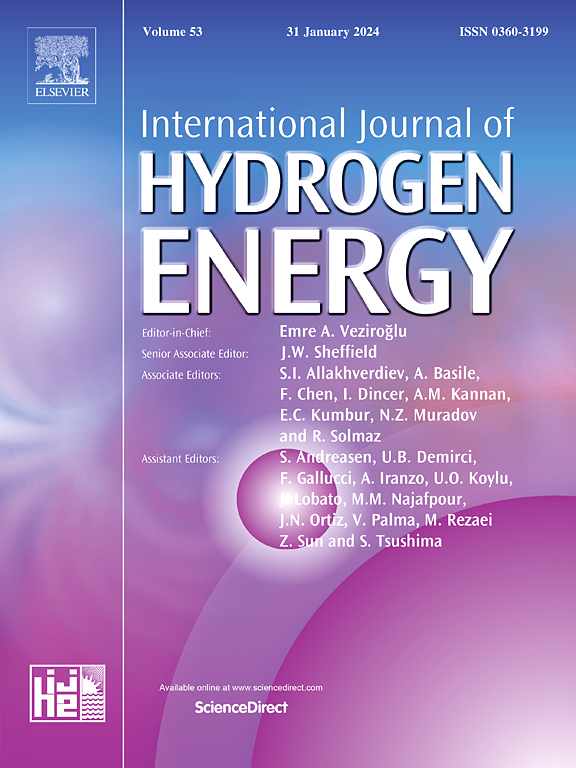质子交换膜燃料电池非原位条件下Cr2SiC陶瓷MAX相包覆金属双极板的研究
IF 8.1
2区 工程技术
Q1 CHEMISTRY, PHYSICAL
引用次数: 0
摘要
对于紧凑轻便的质子交换膜燃料电池(PEMFC)电池组来说,金属双极板(MBPs)由于表面腐蚀和钝化而存在耐用性和导电性问题。本研究对不锈钢(SS) 316l基板上的Cr2SiC陶瓷MAX相涂层进行了非原位表征,以评估其在MBP应用中的适用性。研究内容包括涂层结构、表面形态、耐腐蚀性、表面润湿性、面内导电性和界面接触电阻。x射线衍射和x射线光电子能谱证实了SS316L表面存在Cr2SiC涂层,而能量色散x射线能谱则证实了SS316L表面的覆盖率和元素重量百分比均匀。在25°C (3.29E-03 μA/cm2)和80°C (4.32E-02 μA/cm2)条件下,腐蚀电流密度(Icorr)均较低,耐蚀性能优异,达到美国能源部(DOE)的技术指标。在两种温度下,动电位极化显示出较大的腐蚀电位和较小的Icorr值,优于未涂层样品。电化学阻抗谱后加速腐蚀试验表明,在25℃(3.68E+05 Ω cm2)和80℃(3.02E+05 Ω cm2)下,电荷转移电阻较高,表明在酸性环境中具有稳定性。表面润湿性分析表明,与未涂覆样品相比,涂覆样品的亲水性较低,接触角较大(75°),表面自由能较低(28.92 mJ/m2)。经80℃5 h加速腐蚀试验,导电率达到DOE目标,面内导电率为4.59E+05 S/m,界面接触电阻为8.04 mΩcm2。这些结果表明,Cr2SiC涂层的SS316L具有优异的耐腐蚀性,表面润湿性和电气特性,使其可用于PEMFC应用。本文章由计算机程序翻译,如有差异,请以英文原文为准。
Investigation of Cr2SiC Ceramic MAX Phase Coated Metallic Bipolar Plates in Ex-situ Conditions for Proton Exchange Membrane Fuel Cells
Essential for compact and lightweight proton exchange membrane fuel cell (PEMFC) stacks, metallic bipolar plates (MBPs) suffer from durability and conductivity issues due to surface corrosion and passivation. This study conducts ex-situ characterization of Cr2SiC ceramic MAX phase coatings on stainless steel (SS) 316 L substrates to evaluate their suitability for MBP application. The investigation encompasses coating structure, surface morphology, corrosion resistance, surface wettability, in-plane electrical conductivity, and interfacial contact resistance. X-ray diffraction and X-ray photoelectron spectroscopy confirm the presence of Cr2SiC coatings on SS316L, while energy-dispersive X-ray spectroscopy verifies uniform coverage and elemental weight percentage. Corrosion resistance is evaluated using potentiostatic and potentiodynamic polarization tests, showing excellent resistance with low corrosion current density (Icorr) at both 25 °C (3.29E-03 μA/cm2) and 80 °C (4.32E-02 μA/cm2), meeting US Department of Energy (DOE) technical targets. Potentiodynamic polarization reveals large corrosion potential and small Icorr values at both temperatures, outperforming uncoated samples. Electrochemical impedance spectroscopy post-accelerated corrosion tests show high charge transfer resistance at 25 °C (3.68E+05 Ω cm2) and 80 °C (3.02E+05 Ω cm2), indicating stability in acidic environments. Surface wettability analysis indicates low water affinity with a large contact angle (75°) and low surface free energy (28.92 mJ/m2) for the coated samples as compared to the uncoated samples. Electrical conductivity meets DOE targets with an in-plane conductivity of 4.59E+05 S/m and interfacial contact resistance of 8.04 mΩcm2 after 5-h accelerated corrosion tests at 80 °C. These results suggest that Cr2SiC coated SS316L exhibits excellent corrosion resistance, surface wettability, and electrical characteristics, making them viable for PEMFC applications.
求助全文
通过发布文献求助,成功后即可免费获取论文全文。
去求助
来源期刊

International Journal of Hydrogen Energy
工程技术-环境科学
CiteScore
13.50
自引率
25.00%
发文量
3502
审稿时长
60 days
期刊介绍:
The objective of the International Journal of Hydrogen Energy is to facilitate the exchange of new ideas, technological advancements, and research findings in the field of Hydrogen Energy among scientists and engineers worldwide. This journal showcases original research, both analytical and experimental, covering various aspects of Hydrogen Energy. These include production, storage, transmission, utilization, enabling technologies, environmental impact, economic considerations, and global perspectives on hydrogen and its carriers such as NH3, CH4, alcohols, etc.
The utilization aspect encompasses various methods such as thermochemical (combustion), photochemical, electrochemical (fuel cells), and nuclear conversion of hydrogen, hydrogen isotopes, and hydrogen carriers into thermal, mechanical, and electrical energies. The applications of these energies can be found in transportation (including aerospace), industrial, commercial, and residential sectors.
 求助内容:
求助内容: 应助结果提醒方式:
应助结果提醒方式:


